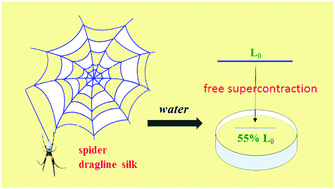Effect of stress on the molecular structure and mechanical properties of supercontracted spider dragline silks†
Abstract
Supercontraction is one of the most interesting properties of spider dragline silks. In this study, changes in the secondary structures of the Nephila edulis spider dragline silk after it was subjected to different supercontraction processes were investigated by integrating synchrotron Fourier transform infrared (S-FTIR) microspectroscopy and mechanical characterization. The results showed that after free supercontraction, the β-sheet lost most of its orientation, while the helix and random coils were almost totally disordered. Interestingly, by conducting different types of supercontractions (i.e., stretching of the free supercontracted spider dragline silk to its original length or performing constrained supercontraction), it was found that although the molecular structures all changed after supercontraction, the mechanical properties almost remained unchanged when the length of the spider dragline silk did not change significantly. The other interesting conclusion obtained is that the manual stretching of a poorly oriented spider dragline silk cannot selectively improve the orientation degree of the β-sheet in the spider silk, but increase the orientation degree of all conformations (β-sheet, helix, and random). These experimental findings not only help to unveil the structure–property–function relationship of natural spider silks, but also provide a useful guideline for the design of biomimetic spider fiber materials.



 Please wait while we load your content...
Please wait while we load your content...